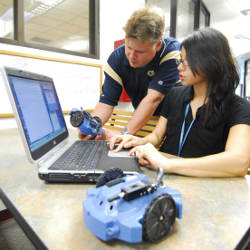
First came videogames, now it’s robots. Universities are trying every which way to interest undergrads in computer science as a major—and the new teaching tools they are using just may be having an impact.
After a period of five years (2000-2005) in which the number of undergrads who intended to be CS majors plummeted by 70 percent, 2008 and 2009 saw renewed interest, says the Computing Research Association’s Computing Research News.
That is gratifying to the Institute for Personal Robots in Education, a Microsoft Research-sponsored joint effort between Georgia Tech and Bryn Mawr. IPRE has developed a curriculum, software, and a plug-in board for an off-the-shelf robot that it hopes will make computer science that much more tantalizing to undergrads.
At least 1,000 students have already participated at some 30 universities and colleges that have adopted IPRE’s program which differs from others in that it is an introductory CS course and it utilizes personal robots that are smaller and less expensive than, say, the ones used in MIT’s lab.
The Scribbler robot from Parallax Inc. is expected to be improved even further with the Scribbler 2 before year-end.
"Instead of sharing the robots, each student has their own which they either purchase for $180 or it gets checked out to them for a full semester," says Jay Summet. "This enables them to spend more time with it, both in the classroom or in their dorm room or at home." Summet helped create the course material for IPRE and now teaches it at Georgia Tech.
One of the first schools to participate was Georgia State where Stefanie Markham is a CS instructor. She has been teaching IPRE’s "introduction to programming" class for two years now and recently co-authored a paper evaluating the course.
"Because there are so many teaching institutions interested in doing something like this, we wanted to function as an independent evaluator and share with them how things are going," she says.
Of the four introductory CS classes being taught at Georgia State, only one utilizes robots—and Markham’s paper compares the results of that course with the robot-less variety.
She explains that the robots enable the students to go beyond the PC’s normal input and output methods—keyboard, screen, and mouse—and "opens the door to lots of cool, interactive ways of getting information in and out of the PC. We have a camera on the robot so we can easily access images; the robot can move around and be made to sing and dance. Without the robot, you sit in front of a screen and just process a lot of numbers. With the robot, you get immediate feedback on whether your program is working, it’s more fun, and students get together and work on their programming so it encourages creativity and a more social environment."
According to her paper, Markham has determined that "the students with robots are spending more of their personal time outside of the classroom programming. They are playing with the robots, figuring them out, and are clearly more intrinsically motivated than the other students."
Indeed, Summet says his Georgia Tech students have team projects where they put on public performances with the robots. "And our associate dean for students brings along videos of the performances when he goes out to high schools. You’d be surprised how excited the high school students get about the course which, naturally, is what we’re trying to achieve."
But are robots the ultimate solution to the problem?
"It’s a little early to say," says Kim King, associate professor emeritus at Georgia State and Stefanie Markham’s co-author. "The robot program is only two years old and we’re still unsure of the long-term results. We think they’re going to be favorable, but that’s hard to tell."
In the meantime, King views the recently rising numbers in CS majors and admits he’s not sure how much can be credited to schools’ innovative efforts to recruit students.
"My guess is that it probably has more to do with the job market than anything else," he says. "I think students have begun to notice that there are jobs in technology and not so many elsewhere. That’s really the big factor for them."
Paul Hyman was editor-in-chief of several hi-tech publications at CMP Media, including Electronic Buyers’ News.



Join the Discussion (0)
Become a Member or Sign In to Post a Comment